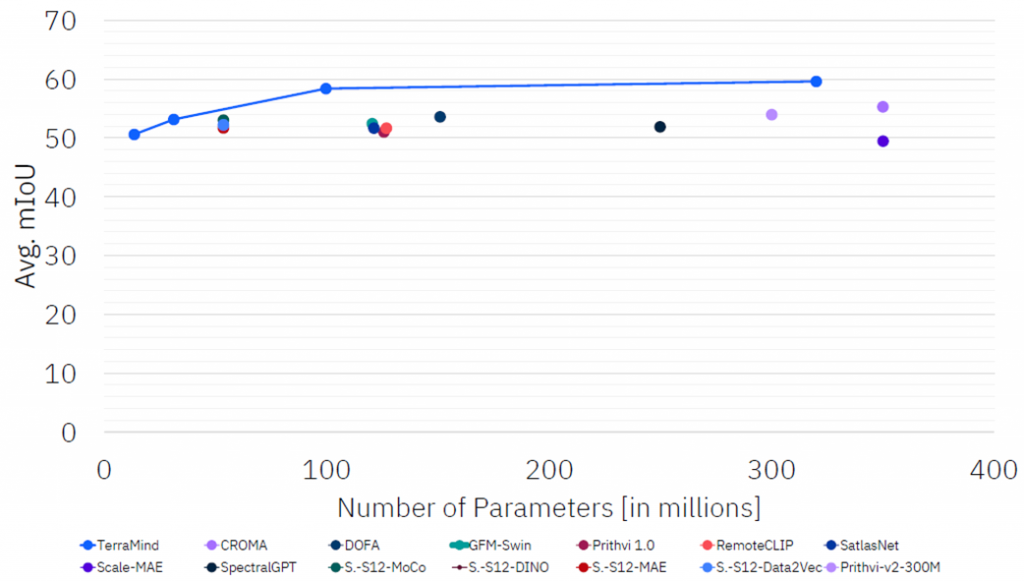Less is more: the power of TerraMind in your pocket and in space



On the last Earth Day, the European Space Agency (ESA) and IBM Research Europe launched TerraMind, a multimodal Earth observation foundation model. While powerful, the model’s need for large computing capabilities for fine-tuning and inference poses certain challenges, particularly in remote or resource-constrained environments. In October 2025, two lighter versions of TerraMind were released to be run on edge devices – like laptops or directly onboard satellites – enabling on-device, real-time analysis. The TerraMind Blue-Sky Challenge launched to even further improve TerraMind and has two new deadlines: 30 November 2025 and 31 January 2026.
Geospatial and Earth observation foundation models are crucial for overcoming global challenges. Pre-trained on vast, globally diverse datasets using self-supervised learning, these models learn a universal “language of Earth”, meaning that they can be quickly fine-tuned with minimal new data and supervised learning to perform a wide range of complex tasks, from disaster response and damage assessment to crop yield forecasting and wildfire spread forecasting.
This drastically reduces the cost, time, and data-labelling efforts required to create actionable insights, making complex Earth observation data more accessible for scientists, policymakers and communities worldwide.
As recalled during the last ESA-NASA International Workshop on AI Foundation Models for EO, the broader challenge now lies in moving beyond rapid-cycle prototyping toward the operational deployment of foundation models for real-world decision-making and societal benefits.
Achieving this requires designing models with deployment as a central consideration — ensuring they are efficient, accountable, and seamlessly interoperable with downstream systems such as digital twins, public dashboards, and early warning platforms. Enabling edge deployment, including onboard satellites, is vital for real-time analysis in resource-constrained environments.
To support this transition, building smaller but efficient models together with robust and scalable software stacks is essential to empower the broader community to adopt and apply these models effectively and responsibly.
In April 2025, ESA Φ-lab and IBM Research Europe launched TerraMind, a multimodal Earth observation foundation model. TerraMind is currently the best performing Earth observation foundation model, assessed by open community benchmarks such as PANGAEA, as it is the only model to outperform other traditional Earth observation methods with a frozen encoder strategy.
Six months later, two lighter versions of TerraMind – TerraMind.tiny and TerraMind.small – were released, specifically engineered to operate on normal or edge hardware devices. Despite their reduced size, these lightweight versions of TerraMind have little decrease in performance – compared with its full-scale version – allowing for model fine-tuning to any downstream use cases just with a standard computer, even without GPUs, or deploying the model to the ultimate edge, directly onboard orbiting satellites.

Besides bringing Earth observation capabilities to edge devices, the creation of the ‘tiny’ and ‘small’ versions of TerraMind also lowers the entry barrier for Earth observation researchers, field workers, or smaller organisations. By drastically reducing the hardware requirements, anyone with a laptop can fine-tune these models and create new applications to better monitor Earth.
“The open-sourcing of the ‘tiny’ and ‘small’ TerraMind models is a game-changer for the entire Earth observation community. This is a clear step towards the true democratisation of planetary-scale foundation models,” commented Nicolas Longépé, Earth Observation Data Scientist at ESA Φ-lab.
“These lightweight versions shatter a barrier imposed by the lack of access to the latest, most powerful GPUs. They maintain industry-leading performance while running efficiently on edge devices and, most importantly, they move the power of cutting-edge AI from the exclusive domain of research centres and companies to the hands of the many who need it most,” Nicolas added.
Although the ‘tiny’ and ‘small’ versions of TerraMind represent a major leap in accessibility, innovation does not stop there: the TerraMind Blue-Sky Challenge, organised by ESA Φ-lab and IBM Research Europe, welcomes innovative ways to push TerraMind beyond “just another fine-tune”, whether it is prototyping a new multimodal workflow, exploring Thinking-in-Modalities, pushing the limits of these tiny but mighty models, or inventing a never-seen geospatial application.
This bi-monthly award has two new submission deadlines – 30 November 2025 and 31 January 2026, 23:59 (AoE). Each winner will receive a € 1.000 cash prize, with a potential publication in a joint wrap-up paper and broad visibility across IBM, ESA, and the Earth observation community. More information about this challenge can be found here.
All versions of TerraMind can be found here. TerraMind was developed within FAST-EO, an initiative led by a consortium comprising DLR, Forschungszentrum Jülich, IBM Research Europe and KP Labs, and supported and funded by ESA Φ-lab.
To know more: ESA and IBM collaborate on TerraMind, IBM ESA Geospatial @ Hugging Face, TerraMind Blue-Sky Challenge
Photo courtesy of Unsplash/Conny Schneider
Share